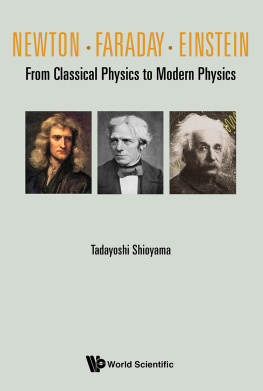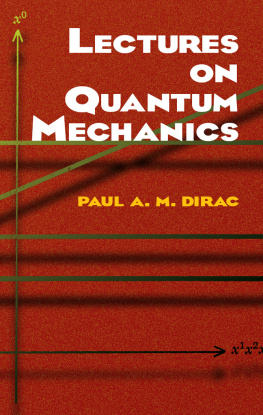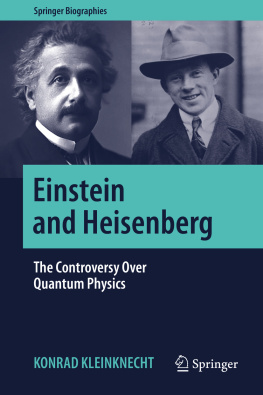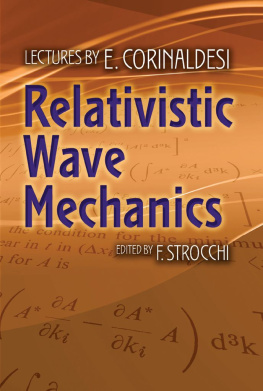Simply Dirac
Helge Kragh
Simply Charly
New York
Copyright 2016 by Helge Kragh
Cover Illustration by Jos Ramos
Cover Design by Scarlett Rugers
All rights reserved. No part of this publication may be reproduced, distributed, or transmitted in any form or by any means, including photocopying, recording, or other electronic or mechanical methods, without the prior written permission of the publisher, except in the case of brief quotations embodied in critical reviews and certain other noncommercial uses permitted by copyright law. For permission requests, write to the publisher at the address below.
ISBN: 978-1-943657-00-1
Brought to you by http://simplycharly.com
Contents
Simply Dirac -- Simply Dirac
Paul Dirac is one of the most influential scientists of the twentieth century, often called the theorists theorist. Yet he is much less well known than many lesser physicists. In Simply Dirac, the distinguished historian Helge Kragh gives an accessible introduction to Diracs most famous contributions to our understanding of the workings of nature, and gives us a good sense of the theoreticians singular personality. A most enjoyable read.
Graham Farmelo, Author of The Strangest Man: The Hidden Life of Paul Dirac, Mystic of the Atom
Kragh, who is a respected colleague and authoritative historian, has taken up an imposing challenge. Diracs work is obscured by three barriers to understanding: The complexity of quantum mechanics, the novelty of Diracs take on this field, and the strangeness of the man. To reveal Diracs genius through this triple veil in such a clear way was no easy task, but one that Kragh has handled remarkably. He is a reliable guide through this difficult terrain and has contributed many valuable insights to this work.
Hans Christian von Baeyer, Chancellor Professor of Physics, Emeritus, at the College of William and Mary
What a fantastic entre into the life of Paul Dirac and the exotic world of Quantum Mechanics, of which he was one of the great pioneers. With its cast of some of the most important scientists of the modern age, this is both an entertaining and an enlightening read.
Michael White, Bestselling author of 39 books including Isaac Newton: The Last Sorcerer
Helge Kragh has crafted an engaging and informative biography of a shy theorist who specialized in difficult physicsa beautiful life in science, in which Paul Diracs strengths and frailties are treated with a light touch.
Simon Mitton, Author of Fred Hoyle: A Life in Science
Written with depth and clarity, Helge Kraghs Simply Dirac is an informative and interesting description of Paul Diracs work and ideas and of his life and legacy. In particular, I found the authors detailed discussions of methodology, something that is often neglected in a biography as well as his discussion of what little philosophy there was in Diracs thinking, illuminating.
Hans S. Plendl, Professor Emeritus of Physics, Florida State University
-- Simply Dirac
Simply Austen by Joan Klingel Ray
Simply Beckett by Katherine Weiss
Simply Beethoven by Leon Plantinga
Simply Chekhov by Carol Apollonio
Simply Chomsky by Raphael Salkie
Simply Chopin by William Smialek
Simply Darwin by Michael Ruse
Simply Descartes by Kurt Smith
Simply Dickens by Paul Schlicke
Simply Einstein by Jimena Canales
Simply Eliot by Joseph Maddrey
Simply Euler by Robert E. Bradley
Simply Faulkner by Philip Weinstein
Simply Fitzgerald by Kim Moreland
Simply Freud by Stephen Frosh
Simply Gdel by Richard Tieszen
Simply Hegel by Robert L. Wicks
Simply Hitchcock by David Sterritt
Simply Joyce by Margot Norris
Simply Machiavelli by Robert Fredona
Simply Napoleon by J. David Markham & Matthew Zarzeczny
Simply Nietzsche by Peter Kail
Simply Proust by Jack Jordan
Simply Riemann by Jeremy Gray
Simply Sartre by David Detmer
Simply Tolstoy by Donna Tussing Orwin
Simply Stravinsky by Pieter van den Toorn
Simply Turing by Michael Olinick
Simply Wagner by Thomas S. Grey
Simply Wittgenstein by James C. Klagge
3
Series Editor's Foreword
S imply Charlys Great Lives series offers brief but authoritative introductions to the worlds most influential peoplescientists, artists, writers, economists, and other historical figures whose contributions have had a meaningful and enduring impact on our society.
Each book provides an illuminating look at the works, ideas, personal lives, and the legacies these individuals left behind, also shedding light on the thought processes, specific events, and experiences that led these remarkable people to their groundbreaking discoveries or other achievements. Additionally, every volume explores various challenges they had to face and overcome to make history in their respective fields, as well as the little-known character traits, quirks, strengths, and frailties, myths, and controversies that sometimes surrounded these personalities.
Our authors are prominent scholars and other top experts who have dedicated their careers to exploring each facet of their subjects work and personal lives.
Unlike many other works that are merely descriptions of the major milestones in a persons life, the Great Lives series goes above and beyond the standard format and content. It brings substance, depth, and clarity to the sometimes-complex lives and works of historys most powerful and influential people.
We hope that by exploring this series, readers will not only gain new knowledge and understanding of what drove these geniuses, but also find inspiration for their own lives. Isnt this what a great book is supposed to do?
Charles Carlini, Simply Charly
New York City
A lthough not well known to the general public, British physicist Paul Dirac (1902-1984) is indisputably one of the giants of modern science. More specifically, he was one of the founders of quantum mechanics, the theory that, together with Einsteins theory of relativity, defines the modern physical world picture at its most fundamental level. Dirac probably contributed more profoundly to the quantum revolution than any other physicist. His amazing outbursts of scientific brilliance were essentially confined to a decade-long period starting in 1925, after which his creativity and interest in mainstream science declined.
Dirac acquired fame not only for his contributions to physics but also because of his peculiar personality, including such traits as extreme reticence and taciturnity. Social skills were not his strong side. His younger contemporary, Richard Feynman, another quantum genius, was once described as a second Dirac, only human.
This book offers a condensed account of Diracs life and science or, more specifically, his life in science. Despite his reserved personality, he was very well connected and during his long career, he interacted with physics luminaries such as Niels Bohr, Werner Heisenberg, J. Robert Oppenheimer, and others. The book is to some extent based on a more detailed and technically demanding monograph I published in 1990, in which one can find further information (







